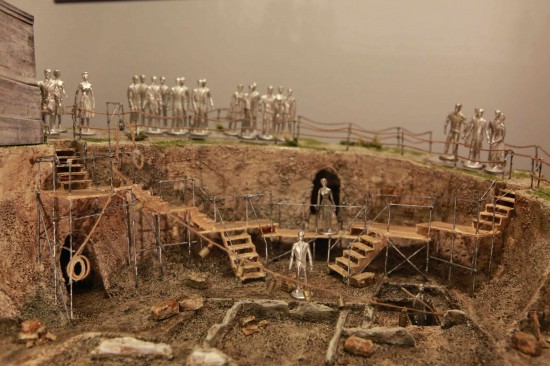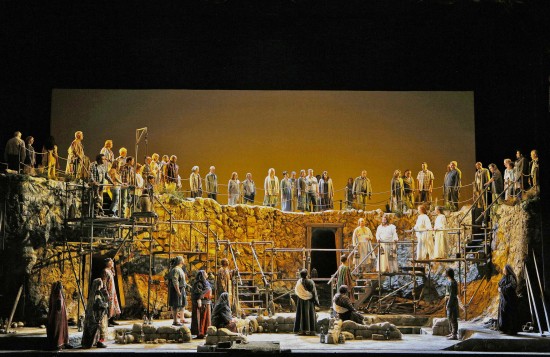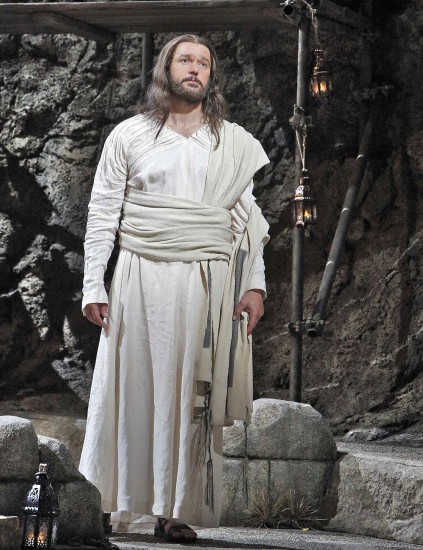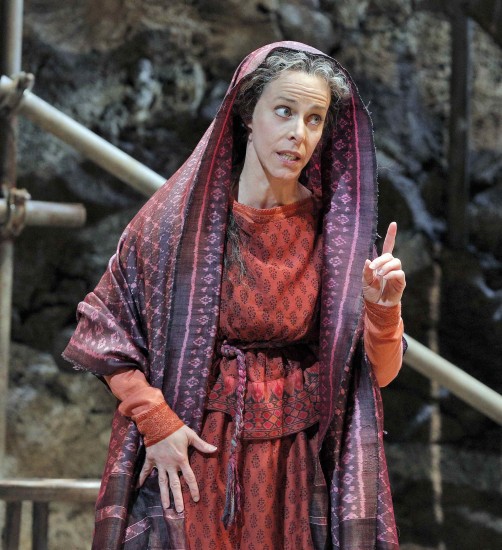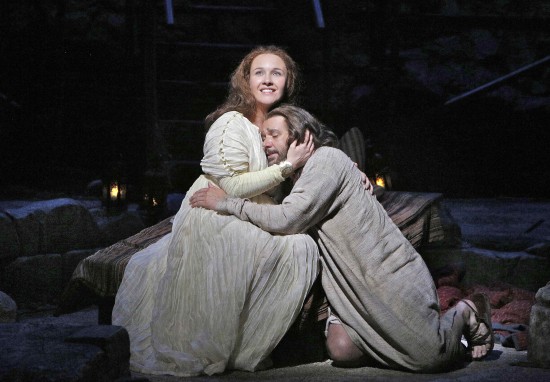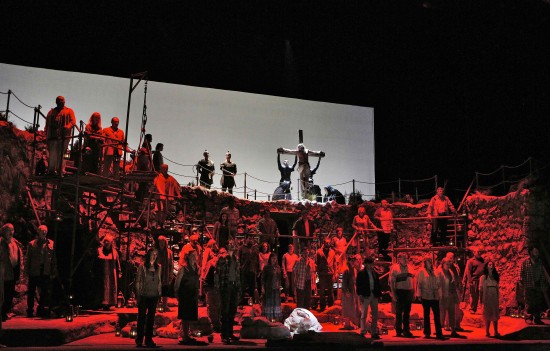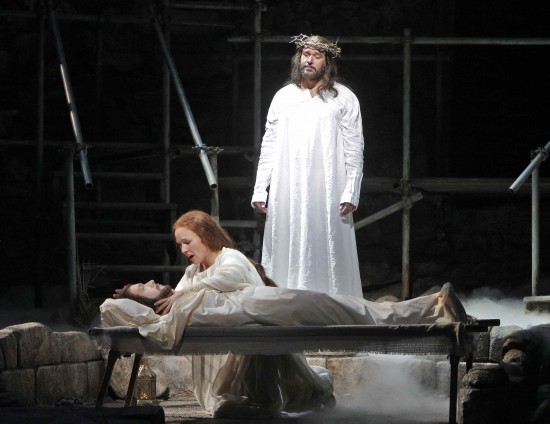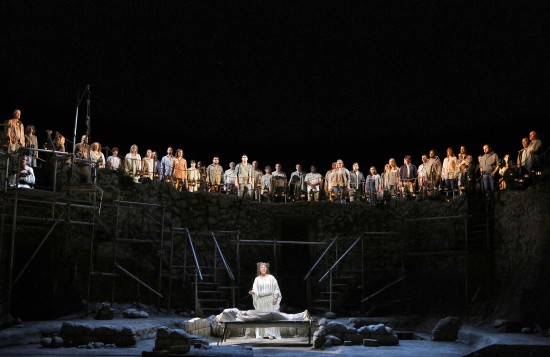For weeks I had been looking forward to the night of Saturday, June 23 2013 and the second performance ever of the world premier production of The Gospel of Mary Magdalene. 
Tension began building a few minutes before the announced starting time of 8:00 when the heavy front curtain went up to show the intriguing set. The bottom of the cast page in the program seemed to present some paradoxical information:
The time is now. The place is Galilee, the first century C. E.
Interesting program articles by the director and by the composer, together with later reference to Wikipedia revealed the following bits of history.
Before about 1890 it was generally believed in the western world that the four gospels (Matthew, Mark, Luke, and John) in the New Testament were the only accounts ever written about the life of Jesus. It came as a shock when an incomplete document written not later than the fifth century C. E. The Gospel of Mary Magdalena was discovered. A half century later a treasure trove of Gnostic manuscripts was discovered including several other gospels.
Five years ago, Mark Adamo, composer of two previous operas, Little Women and Lysistrata, became intrigued by the differences between the various gospels and began to study them intensively to form his own opinion. Who were these human beings named Jesus of Nazareth and Mary of Magdalene.
Adamo¬†found a kindred spirit in¬†David Gockley, General Director of the¬†San Francisco Opera, who commissioned him to write an opera on the subject. Like all good historical drama, the opera has a strong historical background, but it is not history. The principal characters and their important actions are based on the real actions of real people, but minor actions and minor characters may be products of the author’s imagination, chosen for their dramatic quality rather than for historical accuracy. In this case, most of the libretto consists of the English translation of actual words found in the gospel or other related¬†Gnostic manuscripts.

Creative Team (L to R) General Director David Gockley, Composer Mark Adamo, Costume Designer Constance Hoffman, Director Kevin Newbury, Set Designer David Korins; photo from SFOpera files
Libretto and score constitute the paper opera, but we saw more than a paper score Saturday night. We saw an opera production in an opera house by an opera company. And that requires an entire creative team, headed by General Director David Gockley, Composer-librettist Mark Adamo, Costume Designer Constance Hoffman, Director Kevin Newbury, Set Designer David Korins, Lighting Designer Christopher Maravich Рeach with their crew of assistants Рto create the opera. It requires a 65-piece orchestra led by Conductor Michael Christie, a 48-member chorus led by Chorus Director Ian Robertson. Last-but-not-least, it requires 25 solo singers, 4 of whom have major roles Рof whom more later.
Since composer and librettist were the same person, it is not surprising that words and music fit perfectly: every note is right for the action it accompanies; every word is right for the music to which it is sung. The action, the costumes, the lighting are all excellent in themselves. And everything fits together to form a whole even greater than the sum of its parts.
So, let’s get back to that paradox. A group of modern people are excited by the recent manuscript discoveries and visit the archeological dig where they were found, seeking to better understand the real people who inspired the differing gospels two millennia ago. Their concentration is so intense that they recreate the ancient reality – and the opera takes off from there.
We are in Capernaum, ca.30 CE, and Mary Magdalene (Sasha Cooke) is singing her first aria:
Kiss me!
Make me blind with your kisses.
Wake the night!
And when you do, I shall have lost myself.
But when I lose myself,
I find myself, I find myself
In you . . .
She is attempting to find her spiritual self through physical love with Simon (Hadleigh Adams), but Simon’s wife Tara (Marina Harris) appears and threatens to have Mary stoned to death.
Yeshua (Nathan Gunn) appears in the nick of time, “a gaunt young lion of a man, thirty but seemingly younger; severe, humorless, but something hints at an ache within.”
Which husband? Isn’t he your fifth?
Not counting whom you’re sleeping with.
. . . . .
What is she to you?
“Adulterer, adulteress;
The penalty is stoning.”
You can cast this stone?
The next scene is in Capernaum where “three preachers – including Yeshua – expound from the synagogue court. A thin crowd listens as they would to buskers in a Manhattan subway“. A Pharisee (James Creswell) shows up and taunts Yeshua with his illegitimate birth. Yeshua responds angrily,
Damn you. You impostor.
You reek of sin
Each of you’s a whitewashed grave:
Clean on the outside; rotten within!
The Pharisee denigrates his indictment “coming from a . . .¬†“ [he pauses for a beat to allow the onlookers to hiss “Bastard”, then finishes his sentence with] “. . .¬†carpenter. Your work is done here, Nazarene.”¬†“My work has just begun.”¬†“Your work is done here”¬†“My work has just begun.”
The repetition is icy, grows icier, and threatens to continue indefinitely, but Yeshua’s mother Miriam (Maria Kanyova) “forty-five years old, her fleece of black hair streaked with steel” shows up with Yeshua’s two younger brothers:
Rabbi, forgive him.
He’s deranged.
He doesn’t know what he’s done.
We’ll take him. We’ll take care of him.
He’s their brother. He’s my son.
(to Yeshua)
Follow me.
Yeshua merely looks at her, but when she repeats, “Yeshua. Follow me,” he responds stonily, not looking at her, “My mother, my brothers: who are they?”
A few minutes later Yeshua, still denying his mother, has run off followed by his brothers – only the two women are left on stage. Miriam warns Mary,
It’s you. The girl.
The Magdalene woman.
He spoke of you this morning
Rich girl. Sad Girl.
Yearning woman.
I’m giving you a warning.
Run: run like the wind
He will ruin you.
Mary responds carefully but firmly:
But – even if all you say is true,
Maybe I can teach him something, too.
Mother and consort bless each other – they are allies in their love of Yeshua.
Late in Scene 3 policemen bring news of the decapitation of John the Baptist. Yeshua is devastated by the news and overwhelmed by grief and guilt. Mary comforts and calms him and eventually leads him to her bedroom.
Scene 4: The next morning Yeshua is moody, thoughtful, and silent. Mary takes in his mood. She doesn’t press him, but muses aloud – not looking at him – about love and desire:
I can tell you what I’ve learned from you
About how to live;
About giving and receiving love,
And how it’s better to give;
About how love is not the same thing as desire,
And how desire can lie. But –
I can’t say I don’t love you.
And I won’t try.
She continues in this vein for a few pages, all to tender and moving music. Still no response. Finally she gives up and prepares to leave. At the last minute Yeshua speaks, beginning with a whisper but gradually gaining confidence:
But you’ve brought me to life.
Radiant woman, Wisdom –
You’ve brought me to life.
Someday I’ll explain to you
Why I used to believe
That love was low, and shameful –
Why I was naťĮve
Surely I will hurt you and disappoint you,
Sure as day follows night;
Still,
Be with me – Wisdom;
(Mary): I will be with you, always –
(Yeshua): Everywhere with me – Wisdom;
(Mary): Everywhere with you, always –
(together): Every day rejoicing,
Every day, daily my delight.
They touch – and the light fades, ending the most beautiful scene in the opera.
There are too many story lines in this complex opera for me to do justice to all of them. In particular, I have had to neglect the role of Peter (William Burden). Which is a shame, because¬†Burden¬†has perhaps the strongest voice among the quartet of excellent singers. And a couple of the scenes in which he attempts, unsuccessfully, to force Mary from the inner group of disciples have considerable dramatic tension. But choices have to be made, and since time and space are running out, I’ll jump directly to the Crucifixion.
I was truly impressed by the staging of this scene. The entire dig is bathed in an ominous red light, and attention is focused on Peter berating himself for having denied Yeshua to save his own skin, and on Mary attempting to comfort him. Meanwhile, as if in an old silent newsreel, we see the Crucifixion being carried out with enough realism to convey its horror, but silently and far away so that the grisly details were not forced upon us.
The Resurrection is in equally good taste. Mary is in the tomb with Yeshua’s body (obviously a well-sculpted dummy). She has unwrapped its head and is cradling it and talking to it. Silently the Ghost of Yeshua rises behind her, then sings in the voice of¬†Nathan Gunn. We, the audience can decide individually whether we believe in Ghosts or whether it is all in Mary’s mind. My rational mind tells me the latter, but I prefer to suspend my disbelief and believe that although Yeshua’s body is dead, his Spirit lives on.
I would love to quote the whole beautiful duet of this final scene, but I’ll have to be content with only a couple of verses. Mary is discouraged: “What hasn’t died?” she asks, and Yeshua replies that she must tell the world their story:
Tell them.
Tell them what we did.
Tell them what we tried for.
Tell them what we gave.
Tell them.
Tell them that we laughed.
Tell them we were foolish.
Tell them we were brave.
Then, at the very end, Yeshua:
Tell them: and
Ev’rywhere you go,
However far you wander,
However dark the night,
I will be with – Wisdom;
Everywhere with you – Wisdom;
Every day rejoicing,
Daily your delight.
And Mary:
You will be with me, always;
Ev’rywhere, ev’rywhere with me always
Every day rejoicing,
Daily my delight.
I shall
I shall
I shall tell them
Earlier I called Act I Scene 4 “the most beautiful scene in the opera.” I take that back. This final scene, much of it using the same music, is even more beautiful. Run, do not walk, to see one of the remaining performances. You may never, ever, have another opportunity.
Sung in English with English supertitles
Approximate running time: 2 hours, 50 minutes including one intermission
Wed 06/19/13 7:30pm, “®Sat 06/22/13 8:00pm,
Tue 06/25/13 8:00pm, Fri 06/28/13 8:00pm,
Tue 07/2/13 7:30pm, Fri 07/5/13 8:00pm,
Sun 07/7/13 2:00pm
San Francisco Opera
301 Van Ness Avenue
San Francisco, CA 94102
(415) 861-4008
webmaster@sfopera.com
All photos except as noted are by Cory Weaver, San Francisco Opera
All quotes are from the libretto of the opera
This review by Philip G Hodge appeared in sanfranciscosplash.com on June 27, 2013.

